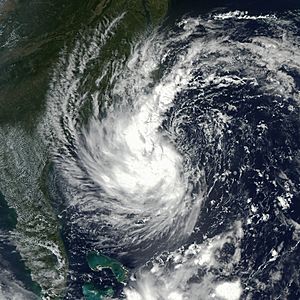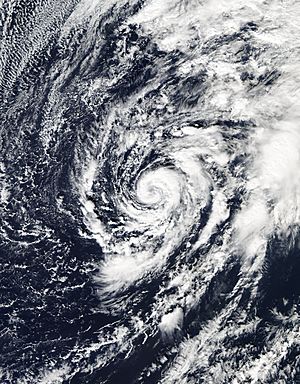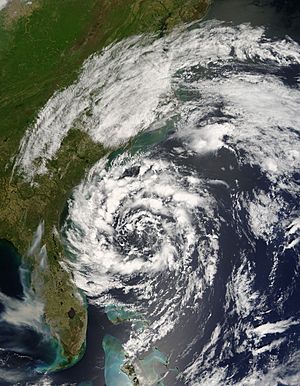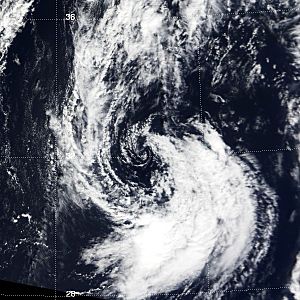Subtropical cyclone facts for kids
A subtropical cyclone (also known as a subtropical storm) is a type of spinning weather storm. Subtropical cyclones have wide wind patterns. The winds get stronger as they move farther away from the center of the storm.
Contents
What is a Subtropical Cyclone?
A subtropical cyclone is a mix between a tropical cyclone (like a hurricane) and an extratropical cyclone (which forms over land or colder waters). These storms are usually found in the northern Atlantic Ocean and the eastern Pacific Ocean.
Most subtropical cyclones have strong winds. Their maximum wind speeds are usually between 39 mph (60 km/h) and 74 mph (110 km/h). If a subtropical cyclone has winds slower than 39 mph, it is called a "subtropical depression."
There is no such thing as a "Subtropical Hurricane." If a storm that was once subtropical gets strong enough to be a hurricane, it has changed into a full tropical or extratropical storm.
History of Subtropical Cyclones

How Subtropical Storms Got Their Name
In the 1950s and 1960s, these storms were simply called "semi-tropical." Weather scientists talked a lot about what a subtropical cyclone really was.
So, in 1972, the National Hurricane Center (NHC) officially made it a new type of storm. It was different from regular tropical cyclones.
Naming Subtropical Storms
During the 1970s, the NHC tried to make a separate list of names for subtropical cyclones. But many scientists did not agree with this idea, so it was stopped. After that, subtropical storms were just given numbers. For example, Hurricane Karen from 2001 was first called Subtropical Storm One.
But in 2002, the rules changed again. Tropical and subtropical storms started to share the same list of names for the whole season. The first subtropical storm to be named under this new rule was Subtropical Storm Nicole in 2004.
In the 2004 Atlantic hurricane season, the NHC officially watched and named Subtropical Storm Nicole. Later, another unnamed subtropical cyclone was found in the 2005 Atlantic hurricane season. This happened after old records were checked again. Even though it could have been named, it stayed unnamed because it was found long after the storm season ended.
A third subtropical cyclone was named Subtropical Storm Andrea. It formed on May 9 just before the start of the 2007 Atlantic hurricane season.
How Subtropical Cyclones Form
A subtropical cyclone can form in several ways:
- It can change from an extratropical cyclone into a tropical cyclone, or the other way around.
- It can form when a low-pressure system high up in the atmosphere meets cold air and strong thunderstorms.
- It can grow from a large mesocyclone (a spinning part of a thunderstorm) that has a cold center.
- It can start from a tropical wave (a type of weather disturbance) over ocean waters that are about 23 degrees Celsius (73 degrees Fahrenheit).
- It can also form from the leftover parts of a tropical cyclone after it has moved over land and lost its tropical features.
Types of Subtropical Cyclones

Upper-Level Low Type
The most common type of subtropical cyclone starts from a cold low-pressure system high in the atmosphere. The spinning winds from this system reach down to the surface. The strongest winds are usually found about 100 miles (160 kilometers) or more away from the center of the storm.
Mesoscale Low Type
Another type of subtropical cyclone is a mesoscale low. This smaller storm forms in areas where winds are blowing in different directions, often near a "dying frontal zone." The strongest winds are usually less than 30 miles (50 kilometers) from the center. The whole storm might be less than 100 miles (160 kilometers) across. These cyclones usually do not last very long.
For a short time in 1972, this type of subtropical cyclone was called a "neutercane." As of 2006, the warm core version of this type was moved under the definition of a tropical cyclone. This means it is no longer considered a subtropical cyclone.
Related Pages
| Cyclones and Tropical cyclones of the World |
|---|
| Cyclone - Tropical - Extratropical - Subtropical - Mesocyclone - Polar cyclone - Polar low |
Images for kids
-
Subtropical Storm Alpha in September 2020, shortly before it made landfall in Portugal. This was unusual.
-
A water vapor loop showing how Subtropical Storm Andrea formed in May 2007.
-
Subtropical Storm Alberto near Florida on May 27, 2018.
-
A subtropical storm in December 2010. It was originally a Kona storm.
See also
 In Spanish: Ciclón subtropical para niños
In Spanish: Ciclón subtropical para niños








